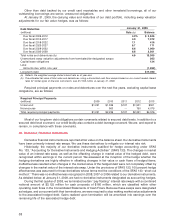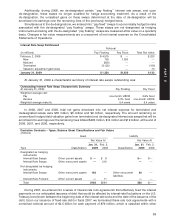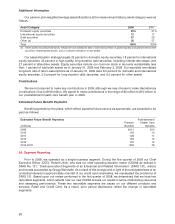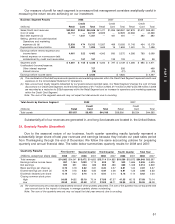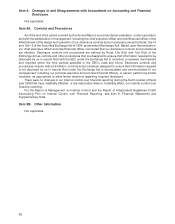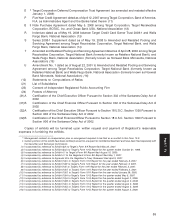Target 2008 Annual Report Download - page 65
Download and view the complete annual report
Please find page 65 of the 2008 Target annual report below. You can navigate through the pages in the report by either clicking on the pages listed below, or by using the keyword search tool below to find specific information within the annual report.
At January 31, 2009, there was $173 million of total unrecognized compensation expense related to
nonvested stock options. That cost is expected to be recognized over a weighted average period of 1.5 years.
The weighted average remaining life of currently exercisable options is 4.8 years, and the weighted average
remaining life of all outstanding options is 6.8 years. The total fair value of options vested was $51 million,
$35 million, and $47 million in 2008, 2007, and 2006, respectively.
Performance share unit award recipients will receive shares of common stock if certain revenue and EPS
growth targets are met and the recipients also satisfy service-based vesting requirements. Compensation
expense associated with outstanding performance share units is recorded over the life of the awards. The
expense recorded each period is dependent upon our estimate of the number of shares that will ultimately be
issued and, for some awards, the current Target common stock price. Future compensation expense for
currently outstanding awards could reach a maximum of $57 million assuming payout of all outstanding
awards. The total share based liabilities paid were $15 million and $18 million in 2008 and 2007, respectively.
There were no share based liabilities paid in 2006.
In 2008, we recorded a $12 million reversal of previously recorded expense related to performance share
units that were to be paid to award recipients at the end of the fiscal year. The related performance share units
will not be delivered to award recipients because we did not meet certain revenue and EPS compound annual
growth rates as set forth in the performance criteria.
Total unrecognized compensation expense related to restricted stock unit awards was $14 million as of
January 31, 2009.
26. Defined Contribution Plans
Team members who meet certain eligibility requirements can participate in a defined contribution 401(k)
plan by investing up to 80 percent of their compensation, as limited by statute or regulation. Generally, we
match 100 percent of each team member’s contribution up to 5 percent of total compensation. Our
contribution to the plan is initially invested in Target common stock. These amounts are free to be diversified
by the team member immediately.
In addition, we maintain nonqualified, unfunded deferred compensation plans for approximately 4,000
current and retired team members whose participation in our 401(k) plan is limited by statute or regulation.
These team members choose from a menu of crediting rate alternatives that are the same as the investment
choices in our 401(k) plan, including Target common stock. We credit an additional 2 percent per year to the
accounts of all active participants, excluding executive officer participants, in part to recognize the risks
inherent to their participation in a plan of this nature. We also maintain a nonqualified, unfunded deferred
compensation plan that was frozen during 1996, covering 11 active and 52 retired participants. In this plan
deferred compensation earns returns tied to market levels of interest rates, plus an additional 6 percent return,
with a minimum of 12 percent and a maximum of 20 percent, as determined by the plan’s terms.
The American Jobs Creation Act of 2004 added Section 409A to the Internal Revenue Code, changing the
federal income tax treatment of nonqualified deferred compensation arrangements. Failure to comply with the
new requirements would result in early taxation of nonqualified deferred compensation arrangements, as well
as a 20 percent penalty tax and additional interest payable to the IRS. In response to these new requirements,
we allowed participants to elect to accelerate the distribution dates for their account balances. Participant
elections resulted in payments of $86 million in 2008 and $74 million in 2007.
We control some of our risk of offering the nonqualified plans through investing in vehicles, including
prepaid forward contracts in our own common stock, that offset a substantial portion of our economic
exposure to the returns of these plans. These investment vehicles are general corporate assets and are
marked-to-market with the related gains and losses recognized in the Consolidated Statements of Operations
in the period they occur. The total change in fair value for contracts indexed to our own common stock
recorded in earnings was pre-tax income/(loss) of $(19) million in 2008, $6 million in 2007 and $37 million in
2006. During 2008 and 2007, we invested approximately $215 million and $164 million, respectively, in such
investment instruments, and these investments are included in the Consolidated Statements of Cash Flows
within other investing activities. Adjusting our position in these investment vehicles may involve repurchasing
shares of Target common stock when settling the forward contracts. In 2008, 2007 and 2006, these
45
PART II





